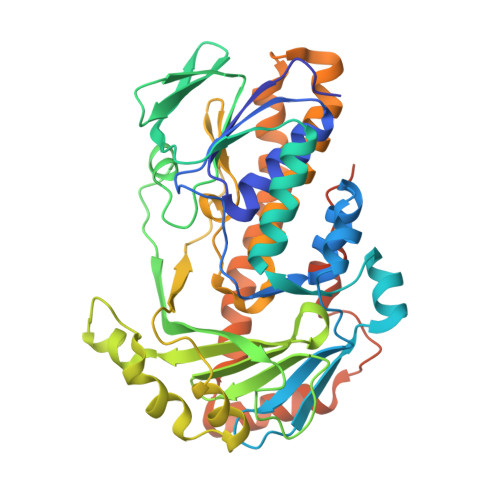3-Hydroxybenzoate 6-Hydroxylase from Rhodococcus jostii RHA1 Contains a Phosphatidylinositol Cofactor.
Montersino, S., Te Poele, E., Orru, R., Westphal, A.H., Barendregt, A., Heck, A.J.R., van der Geize, R., Dijkhuizen, L., Mattevi, A., van Berkel, W.J.H.(2017) Front Microbiol 8: 1110-1110
- PubMed: 28670303
- DOI: https://doi.org/10.3389/fmicb.2017.01110
- Primary Citation of Related Structures:
5HYM - PubMed Abstract:
3-Hydroxybenzoate 6-hydroxylase (3HB6H, EC 1.13.14.26) is a FAD-dependent monooxygenase involved in the catabolism of aromatic compounds in soil microorganisms. 3HB6H is unique among flavoprotein hydroxylases in that it harbors a phospholipid ligand. The purified protein obtained from expressing the gene encoding 3HB6H from Rhodococcus jostii RHA1 in the host Escherichia coli contains a mixture of phosphatidylglycerol and phosphatidylethanolamine, which are the major constituents of E. coli's cytoplasmic membrane. Here, we purified 3HB6H ( Rj HB6H) produced in the host R. jostii RHA#2 by employing a newly developed actinomycete expression system. Biochemical and biophysical analysis revealed that Rj 3HB6H possesses similar catalytic and structural features as 3HB6H, but now contains phosphatidylinositol, which is a specific constituent of actinomycete membranes. Native mass spectrometry suggests that the lipid cofactor stabilizes monomer-monomer contact. Lipid analysis of 3HB6H from Pseudomonas alcaligenes NCIMB 9867 ( Pa 3HB6H) produced in E. coli supports the conclusion that 3HB6H enzymes have an intrinsic ability to bind phospholipids with different specificity, reflecting the membrane composition of their bacterial host.
Organizational Affiliation:
Laboratory of Biochemistry, Wageningen University and ResearchWageningen, Netherlands.

















